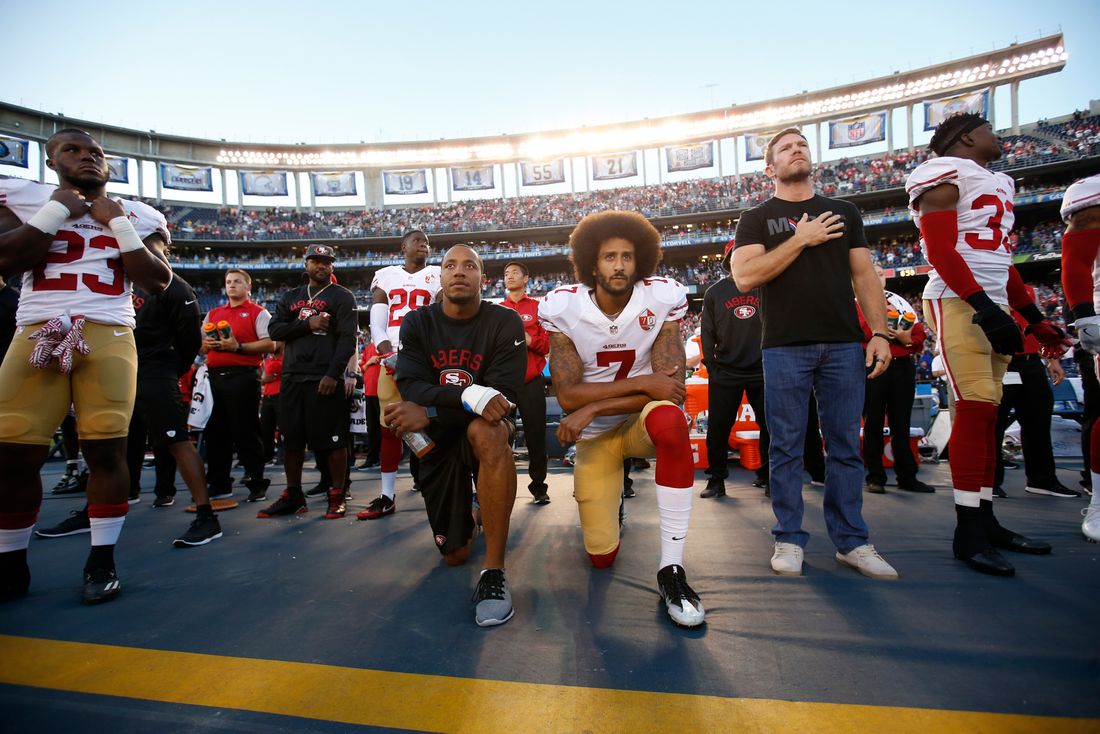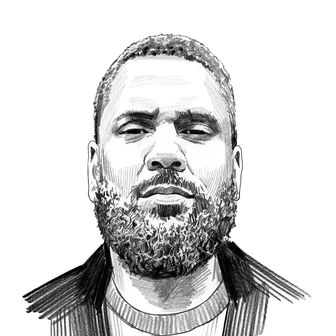
Unless you know what to look for, it’s not clear why the photo is notable, let alone historic. It shows a football field, Levi’s Stadium in Santa Clara, California, before the start of a game. The teams are on their respective sidelines. Nothing is happening. The playing surface is still smooth, and if anything stands out, it’s the 50-yard-line logo: SF, for San Francisco. If you aren’t looking closely for the player wearing No. 7, the only one sitting down, you’ll probably miss him.
But he’s there, a red speck near the bottom of the frame. Colin Kaepernick’s protest would soon upend the world of professional sports, though nine months earlier, his body had betrayed him. He had lost his starting-quarterback gig to a younger player and suffered a season-ending labrum tear in his shoulder that required surgery. He was 29 years old and three years removed from his Super Bowl appearance, and success had eluded him since then. Criticisms he had faced since becoming a starter — that he was physically impressive but cognitively limited, uneasy in the pocket and unable to read defenses — had fueled the broad impression that he was little more than a body.
So by August 2016, when a reporter named Jennifer Lee Chan photographed Kaepernick’s first documented refusal to stand during the national anthem, igniting a controversy that led to his vilification by the Trumpist right and his blackballing by the league’s owners, the ailing quarterback wasn’t just out for justice. He was seeking control.
A paradox of professional athletics is how mastery over one’s body facilitates its surrender. Few jobs call for such exhaustive submission to the dominion of other people. Players spend years fine-tuning muscles most people don’t even know exist, breaking them down and rebuilding them to perform astonishing feats under duress, only to realize that autonomy is an illusion. Team executives use athletes as assets to trade and discard as it suits them, while spectators project and process their neuroses through the players.
Kaepernick’s battle raged on two fronts. A maelstrom of circumstances gave the Black Lives Matter movement its unique contours, and one of the more striking aspects was the involvement of high-profile athletes, many of whom were negotiating professional reckonings at the same time. This was not a coincidence. When LeBron James led his Miami Heat teammates in their silent protest after the killing of Trayvon Martin in 2012, he was less than two years removed from his infamous “Decision” to leave the Cleveland Cavaliers and join rivals Dwyane Wade and Chris Bosh in South Beach to form the NBA’s first modern superteam — an alliance of stars who would have, in years past, sought championships as leaders of their own franchises.
The next half-decade saw James smeared as a traitor and accused of ruining the sport. Since then, the formulation he pioneered has become the league norm, heralding a departure from the days when players settled for the hand fate dealt them when they were drafted. A new age had come, marked by greater self-determination over how and where their bodies were deployed.
Variations on this theme echoed across sports. In women’s athletics, it often materialized in disputes over equal pay. The killing of Michael Brown by a Ferguson, Missouri, police officer in 2014 came months into an intensifying debate about WNBA players flying overseas for money. Brittney Griner, it was reported, earned 12 times more to play in a Chinese league during the WNBA’s off-season than she received during her entire rookie campaign with the Phoenix Mercury. The resulting discontent rippled outward; after the killings of Philando Castile and Alton Sterling in 2016, WNBA players wore BLACK LIVES MATTER–emblazoned shirts to their pregame warm-ups and declined to talk to reporters about anything besides police violence, resulting in fines from the league.
The U.S. women’s soccer team was fresh off their victory at the 2015 World Cup when Megan Rapinoe knelt during the national anthem in solidarity with Kaepernick. They were embroiled in their own push for equal pay, premised on the absurdity of earning less money than their flailing male counterparts. Tennis star Naomi Osaka has made her support for the Black Lives Matter movement an exception to her reluctance to speak in public. Simone Biles, the most decorated gymnast in history, became an outspoken supporter of the movement as she openly assailed her profession’s sanctioning body, USA Gymnastics, for enabling the sexual abuse of its athletes by Dr. Larry Nassar.
For his part, Kaepernick’s dilemmas weren’t limited to his injuries or deteriorating relationship with the 49ers. Revelations about the long-term effects of concussions among NFL players had recently turned litigious, forcing the league to admit, after years of lying and thousands of lawsuits from ex-players, that football and chronic traumatic encephalopathy were linked.
All of these conflicts dealt with a basic question — how athletes might take greater control of the way their bodies are used — that was coming into focus for the players long before the misuse and abuse of human bodies became a national fixation. And for many, these concerns would only get more entwined. When NBA players initiated a wildcat strike during the COVID-disrupted homestretch of the 2020 season, it was nominally about getting more league support for that summer’s protests. But the strike followed a series of physical attacks against their fellow players by the police. Thabo Sefolosha, then a forward for the Atlanta Hawks, had his fibula broken by cops outside a New York City nightclub in 2015. Milwaukee police officers assaulted then–Bucks guard Sterling Brown in a Walgreens parking lot in 2018.
Historically, the challenge of such paradigm-shifting moments has been less about drawing attention to these outrageous injustices to energize the public than funneling that energy into lasting solutions. Just as the advantages of athlete involvement in the Black Lives Matter movement were self-evident — its help in mainstreaming once-marginal ideas about racism and policing, for example — so were its drawbacks. A celebrity milieu begets celebrity-driven problem-solving. The NBA’s strike broke not after radical changes to how this country addresses public safety but after some players phoned Barack Obama, who advised them to establish a “social-justice committee” and keep playing. The banner result was the league’s making some of its arenas available as voter precincts in the 2020 election — almost a cruel joke, in retrospect, given how ineffectual the subsequent Congress has been in passing police reforms.
Elsewhere, the athletes’ particular mix of concerns, social and professional, skewed queasily and predictably toward the latter. The glaring refusal of many NBA players to admit that the Chinese government’s abuses of the country’s Uighur minority were, in fact, bad — China is a huge revenue generator for the league — often overwhelmed their cries for human rights in the U.S.
One thread stands out, though: the galvanizing potential of feeling precarious. The psychic bridge that links the worries of a teenager walking home in suburban St. Louis to those of a multimillionaire athlete in Santa Clara is clear once you recognize that both look in the mirror and see a body in peril. This is not to equate the two but to note their rare convergence over the past decade — and to ask what its rareness says about the long-term durability of their shared response. Can precarity felt by rich and famous athletes sustain ten more years of their investment in this movement? The only certainty, for now, is that the police will give them plenty of opportunities to show us.






























